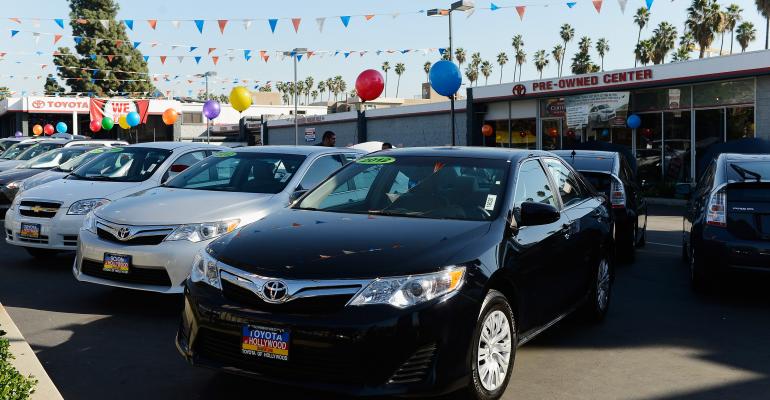Declining used-car values are putting pressure on new-car sales, says Larry Dominique, president of residual predictor ALG.
“We think automakers will put more incentives on new cars to compete against used-car sales because all of a sudden late-model used cars are more affordable,” he tells WardsAuto. “We’re starting to see that.”
Wholesale used-vehicle values declined about 2% in the third quarter.
With only an occasional downtick, used-car prices had enjoyed a streak because of high demand and low supplies.
But as used-car supplies increase, due to better new-car auto sales of two and three years ago, pre-owed vehicle prices are coming down.
The new- and used-car markets always interact at some level. But things are expected to get interesting as the natural price gap between the two narrows.
“Dealers are hungry for used cars,” Dominique says. “That’s one of the reasons automakers’ certified pre-owned programs have become more popular. We’ve seen manufacturers incentivize those dealership programs, usually in the form of lower-rate financing.
“But if you are a manufacturer promoting used-car programs, and used-car prices are coming down, you are almost competing against your new-car sales. And automakers make their money by selling new cars.”
But dealers make more money selling used cars. That’s why many new-car franchise dealers have stepped up their used-car game, as evidenced by the performance levels of dealers on the WardsAuto Remarketing 150.
Collectively, dealers on the ranking list sold 304,425 used cars, earning revenues totaling more than $6 billion last year.
Franchised new-car dealers have pulled ahead of independent used-car dealers in the number of pre-owned vehicles they sell.
At one point until a few years ago, the two groups were neck and neck, each roughly selling 15 million used units a year. Then franchised dealers took a slight lead. Now, they’re way ahead.
In 2013, franchised dealers sold 15.7 million used vehicles. Independent used-car dealers sold 14.3 million. Twelve million more were sold in private-party transactions.
The third-quarter drop in used-car prices is good for dealers in certain ways, Manheim Chief Economist Tom Webb says, calling it “part of a healthy overall market.”
He adds: “Valuation adjustments enabled dealers not only to retail the large number of customer trade-ins and lease returns, but also actively purchase from the growing supply of late-model vehicles available at auction.
“Dealers were able to turn their inventory more quickly because of the lower wholesale prices.”
Manheim sees the used-car price decline as signaling a market returning to more normal levels after historically high prices earlier this year.
After posting increases over the winter and early spring, used-vehicle prices fell for five straight months through September. Pickup trucks were an exception.
A boom in new car sales during the quarter resulted in more trade-ins and lease turn-ins in the quarter. That increased used-car inventories and reduced prices, Manheim says.
But the price declines occurred amid a series of positives. For example, loan delinquencies and repossessions remained low.
Dealers also closed out the quarter with higher retail-unit sales in September, moving more vehicles as prices dropped, Webb says.
Third-quarter wholesale pricing for individual segments was as follows:
- Compact cars continued to be the weakest segment with prices ending the quarter down 3.4% compared with a year ago.
- Midsize cars matched the overall market and experienced a 1.1 percent decline in values compared with a year ago.
- Luxury cars fell 3% compared with a year ago. The multi-year decline in luxury cars appeared to be slowing in September.
- Pickups and vans remain the strongest segment with prices up 6.5% for pick-ups and 1.5% for vans. Owners tend to keep their vehicles for longer. That keeps supplies tighter, even as the overall market increases.
- SUVs and CUVs prices were down 1.5% to end the quarter compared to a year ago. Normally one of the stronger segments, SUV and CUV prices fell in-line with the overall market.
The automotive industry was one of the first sectors to recover from the recession, and consequently may show less upside for the rest of the year, Webb says.
“Although economic forces suggest the retail consumer sector will improve in the months ahead, it is likely that the auto industry will plateau given that it got out ahead of, and then ran considerably faster than, the overall recovery,” he says.
That means “we should see a return to more normal prices and volumes across the entire industry.”
Used-car depreciation rates are expected to continue into early 2015, says Ricky Beggs, editorial director of Black Book used-car price guide.
“We will be keeping a close eye out for luxury-type car segments, which are expected to show larger levels of depreciation through the remainder of the year,” he says.
He’s also on the lookout for used compact-car prices to decline as gasoline prices drop.




